Construction mega projects: Projects for the ages
04 December 2019
Bigger doesn’t always mean better, and so this article looks at a selection of the most interesting projects around the world that have caught our attention due to their size, costs, location or innovative methods of construction. As such, this is not a definitive list of the world’s biggest projects, rather a selected look at some of the most interesting construction projects from around the world.
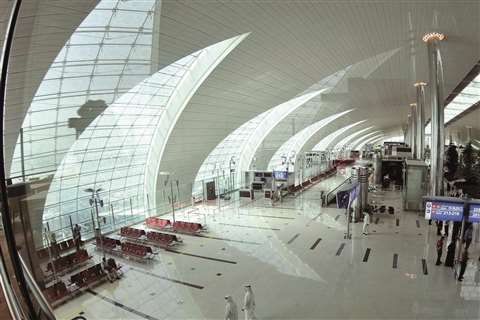
Al Maktoum International Airport, UAE
Construction activity is slowing down in Dubai in the United Arab Emirates. Information from GlobalData recently revealed that the value of projects underway in Dubai has fallen by US$10.9 billion in the first three quarters of 2019 compared to the same period in 2018.
The slowdown in Dubai’s project sector has accelerated in 2019 as the total value of construction and transport project contract awards failed to keep pace with the large volume of projects being completed, such as at the upcoming 2020 World Expo in Dubai.
Due to this decline in new projects the largest upcoming project, the US$33 billion expansion of Al-Maktoum International Airport, has increased importance to the region. Work is progressing, although last year the target opening date for the first phase was moved back from 2025 to 2030.
A US$2.7 billion substructure package is currently being tendered for the expansion of the airport. It is reported to be the biggest construction contract to be tendered in Dubai this year and is said to be of pivotal importance for the future of Dubai’s construction sector.
Colin Foreman, deputy editor at GlobalData, said, “If the contract is awarded it will not only create work for the winning contractor, it will catalyse the further development of Dubai South, and the area surrounding the Dubai Expo site. Conversely, if tender is cancelled or delayed then it will further undermine the already fragile confidence in Dubai’s construction sector.”

New wharf, Antarctic
The first construction phase of a new wharf at the Rothera British Antarctic Survey (BAS) research centre has been completed.
The final BAM construction team members have boarded a ship to make their way home following six-months of construction work, which was supported by BAS’s Technical Advisors, Ramboll.
During the season the team dismantled the existing wharf to make way for the new skeleton structure, with six of the 20 steel frames successfully installed.
Towards the end of the season the teams installed steel piles and backfilled with rock to protect the new sections of the wharf from icebergs during the harsh Antarctic winter. All the plant and equipment have been ‘winterised’ in preperation for phase two of the construction.
Once complete, the new 74m long wharf will be larger and deeper than the previous one to accommodate the new polar research vessel, the RRS Sir David Attenborough that will come into operation in 2020.
The new wharf will also improve experiences for research and operational personnel working at Rothera. A new crane and enhanced cargo handling facilities will make it easier and quicker to load and unload cargo, whilst enhancing facilities for deploying small boats and gliders used for scientific purposes more efficiently.
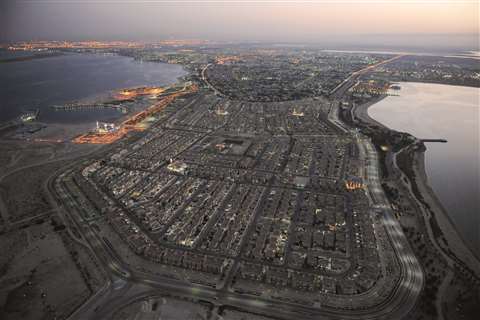
Jubail industrial city, Saudi Arabia
Construction of Jubail is one of the biggest civil engineering projects of modern times. Work actually began in the mid-1970s but is still ongoing, with the project most recently extended for a further five years in 2016.
The contractor Bechtel has managed the project since it began. The development comprises two ports – industrial and commercial – located within a 44km2 artificial harbor protected by 18km of breakwater.
King Fahd Industrial Port handles steel, fertilisers, chemicals, petrochemicals, and other sectors. It handles liquid cargo and dry bulk – such as iron ore, alumina and sulfur – at solids and liquid quays, and a 178-hectare refinery tank farm. Offshore terminals berth 300,000 tonnage product tankers and unload iron ore from 200,000 tonnage bulk carriers.
The commercial port that handles general cargo will have 20 berths and handle all general cargo for the entire industrial complex, as well as for a large surrounding region of Saudi Arabia.
The development also comprises a 9km by 300m causeway, with a four-berth open-sea tank terminal, a dry-bulk terminal with nine berths, a service quay, and a module-import facility.
At its peak, the workforce reached 20,000 per month. Total installed cost exceeded US$20 billion (1976-2016).
With a population of more than 100,000, Jubail is said to account for more than 7% of Saudi Arabia’s GDP (gross domestic product).
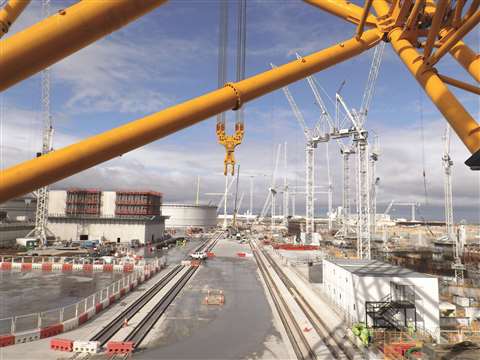
Hinkley Point, England
Hinkley Point C is one of the largest construction projects taking place in the United Kingdom. Approximately 50 tower cranes are expected onsite and the world’s largest crane is already at work.
Energy provider EDF Energy is building two new nuclear reactors at Hinkley Point C (HPC) in Somerset, UK. HPC is the first new nuclear power station to be built in the UK in over 20 years and the project is extensive, with over 4,000 workers presently onsite. During peak construction it is expected that up to 5,600 people will be working on the project at any one time.
Construction started in the second half of 2016 and it is expected to take around ten years to complete. It is reported that three million tonnes of concrete will be needed to build HPC and the construction cost is estimated to be £20 billion (US$25 billion). The power station is scheduled to provide 7% of the UK’s electricity by 2025.
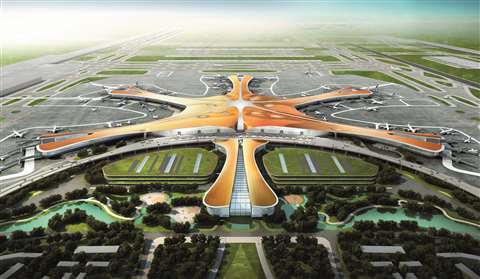
Beijing Daxing International Airport, China
The Phoenix-shaped Beijing Daxing International Airport in China has been built to handle 100 million people passing through it. The project incorporates the largest single-structure airport terminal in the world.
To ensure a dense, stable base treatment that is resistant to water infiltration and erosion, the design called for dynamic compaction. This is the practice of repeatedly dropping a heavy weight on the ground at regular intervals to increase the bearing capacity of the base soil.
Conventional compaction practices can be time-consuming and inconsistent. It begins with the creation of a manual grid layout before a crawler crane and a heavy weight are positioned in the drop zone. One person measures and records the starting elevation of the weight using an optical level and staff. The lift and drop process is repeated 10-15 times per location; a process that takes an estimated 1.5 minutes before the crane and weight are repositioned and the process is repeated.
Manually gathered data is compiled to determine drop-to-drop displacement of the ground and total displacement of the ground over the total number of drops.
The first step in the technology-enabled approach was to automate the grid development. Errors in a manually developed 4x4m grid resulted in up to 0.80m difference between drop locations. The team eliminated this error by using a total station or laser alignment system.
Further, the grid was created automatically with Trimble Business Center software, eliminating manual layout errors and improving the accuracy of the grid of drop locations. Trimble Business Center software was also used for post compaction analysis operations.
In the field, the site was equipped with a single Global Navigation Satellite System (GNSS) base station with integrated radio to manage all machine control, compaction and surveying/site positioning operations.
The crane was equipped with GNSS antennas to provide navigation control for the operator to move the crane and the weight between drop locations with navigation display guiding the operator to the correct location for drops, with a drop-to-drop displacement value of better than 0.05m accuracy.
The productivity and quality improvements of the automated compaction system was said to be especially visible in the real-time analysis of data. The end-to-end automated solution incorporates an automated drop counting system, hydraulic pressure sensing technology and an automatic weight recognition system to measure boom deflections.
The number of drops and the drop-to-drop displacements are captured and computed, providing the crane operator with direct feedback and data delivered to a central database through wireless communications after each drop. Progress information can also be linked directly to project schedules, allowing for real-time review of activities and costs.
Performance metrics estimate that the automated machine system increased the productivity of the operation by 50%.

Information supplied by Mr Zhibin Gao, senior engineer, Capital Airports Holding Company of China and project team leader for the airport. He holds a PHD in Engineering from Tsinghua University, Beijing, China.
Texas high speed rail
There are high-speed rail projects ongoing around the world that have higher costs, or that travel a greater distance than this scheme. Why this project is especially interesting is its location: the US.
It was recently announced by Texas Central that a design-build contract has been signed with the joint venture of Salini Impregilo and its US subsidiary, Lane Construction Corporation, for a high-speed train connecting Houston and Dallas in Texas, US.
The high-speed rail link would cut the journey time between the cities of Houston and Dallas to around 90 minutes. The project’s total investment is expected to be approximately US$20 billion with the civil works estimated at US$14 billion.
Work is scheduled to begin in 2020 – following the conclusion of the approval process for the project – and the high-speed rail is expected to be operational in 2026.
The project is expected to lead to the creation of 10,000 jobs per year during peak construction and 1,500 permanent jobs when fully operational. The Texas train will be based on Central Japan Railway’s Tokaido Shinkansen train system.
In California a high-speed train line was due to open in 2029 at a cost of US$32 billion, but the latest estimates are that it won’t open until 2033 at double the initial cost. These issues have done nothing for a country that is, generally, sceptical of high-speed rail. If the Texas high-speed rail project can be completed near to budget and on-time it could lead to more projects like this in the coming years in a country that is certainly geographically big enough to merit high-speed rail.
New Santa Cruz, Bolivia
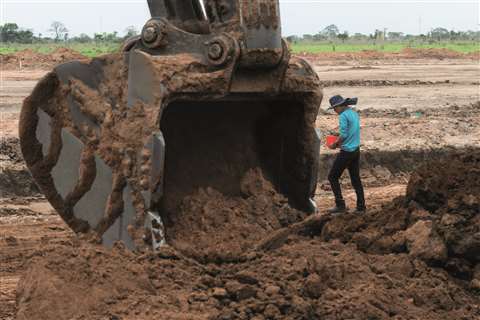
With Santa Cruz, Bolivia, emerging as one of Latin America’s fastest growing cities, it is struggling to control its growth. Now a brand-new city is being built from the ground up to ease the town’s accelerated urbanisation.
Volvo Construction Equipment (Volvo CE) is being used to break ground on construction of the New Santa Cruz – a sibling city just 20 minutes outside of Santa Cruz – which is being built to house more than 370,000 new inhabitants and 10,000 new businesses. The scheme is designed to further boost economic growth and become a symbol for sustainable urban planning.
Fueled by profits from oil, gas and food production and bordering Brazil and Paraguay, Santa Cruz is now close to almost three million residents. It is the 14th fastest growing metropolis in the world and its urban sprawl is set to expand even further with a doubling of its population over the next 15 years.
The city’s rapid growth, coupled with its strategic location in the heart of Latin America and an expansive infrastructure network, has led to the conception of an urbanisation masterplan.
Bolstered by a US$2.5 billion investment and led by developers La Fuente Group, New Santa Cruz will be made up of 700 hectares of commercial space, 3,000 hectares of housing and a further 2,500 hectares of green space. The multi-dimensial site will combine the need to accommodate commercial trade with providing sustainable living. It will make use of existing connections from the Viru Viru international Airport, the Bolivia-Brazil railroad network and other major highways.
Construction of New Santa Cruz is being carried out in phases, with the groundwork for the first phase only recently beginning. More than 100 Volvo CE machines, among them compactors, wheeled loaders and excavators, were chosen to lead on construction because of the machines’ ability to operate in Bolivia’s conflicting climates – suited to both the high and dry conditions in La Paz and the wet lowlands of Santa Cruz.




